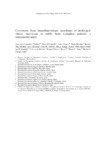Mostrar o rexistro simple do ítem
Conversion from immediate-release tacrolimus to prolonged-release tacrolimus in stable heart transplant patients: a retrospective study
| dc.contributor.author | González-Vílchez, Francisco | |
| dc.contributor.author | Delgado Jiménez, Juan Francisco | |
| dc.contributor.author | Palomo, Jesús | |
| dc.contributor.author | Mirabet, Sonia | |
| dc.contributor.author | Díaz Molina, Beatriz | |
| dc.contributor.author | Almenar-Bonet, Luis | |
| dc.contributor.author | Arizón-del-Prado, José M. | |
| dc.contributor.author | Rangel-Sousa, Diego | |
| dc.contributor.author | Pérez-Villa, Félix | |
| dc.contributor.author | Garrido, Iris P. | |
| dc.contributor.author | Fuente, Luis de la | |
| dc.contributor.author | Gómez-Bueno, Manuel | |
| dc.contributor.author | Sanz-Julve, Marisa | |
| dc.contributor.author | Crespo-Leiro, María Generosa | |
| dc.date.accessioned | 2019-11-18T10:32:54Z | |
| dc.date.issued | 2019-07-01 | |
| dc.identifier.citation | González Vílchez F, Delgado JF, Palomo J, et al. Conversion from immediate-release tacrolimus to prolonged-release tacrolimus in stable heart transplant patients: a retrospective study. Transplant Proc. 2019; 51(6):1994-2001 | es_ES |
| dc.identifier.issn | 1873-2623 | |
| dc.identifier.uri | http://hdl.handle.net/2183/24325 | |
| dc.description.abstract | [Abstract] Background Lifelong adherence with post-transplant immunosuppression is challenging, with nonadherence associated with greater acute rejection (AR) risk. Methods This retrospective study evaluated conversion from immediate-release tacrolimus (IRT) to prolonged-release tacrolimus (PRT), between January 2008 and December 2012 in stable adult heart transplant recipients. Cumulative incidence rate (IR) of AR and infection pre- and postconversion, safety, tacrolimus dose and trough levels, concomitant immunosuppression, and PRT discontinuation were analyzed (intention-to-treat population). Results Overall, 467 patients (mean age, 59.3 [SD, 13.3] years) converted to PRT at 5.1 (SD, 4.9) years post transplant and were followed for 3.4 (SD, 1.5) years. During the 6 months post conversion, 5 patients (1.1%; 95% CI, 0.35%–2.48%) had an AR episode and IR was 2.2/100 patient-years (95% CI, 0.91–5.26). Incidence of rejection preconversion varied by time from transplant to conversion. Infection IR was similar post- and preconversion (9.2/100 patient-years [95% CI, 7.4–11.3] vs 10.6/100 patient-years [95% CI, 8.8–12.3], respectively; P = .20). Safety variables remained similar post conversion. The IR of mortality/graft loss was 2.3/100 patient-years (95% CI, 1.7–3.1). Conclusions Conversion from IRT to PRT in heart transplant recipients in Spain was associated with no new safety concerns and appropriate immunosuppressive effectiveness. | es_ES |
| dc.language.iso | eng | es_ES |
| dc.publisher | Elsevier | es_ES |
| dc.relation.uri | https://www.doi.org/10.1016/j.transproceed.2019.04.028 | es_ES |
| dc.rights | Atribución-NoComercial-SinDerivadas 3.0 España | es_ES |
| dc.rights.uri | http://creativecommons.org/licenses/by-nc-nd/3.0/es/ | * |
| dc.title | Conversion from immediate-release tacrolimus to prolonged-release tacrolimus in stable heart transplant patients: a retrospective study | es_ES |
| dc.type | info:eu-repo/semantics/article | es_ES |
| dc.rights.access | info:eu-repo/semantics/embargoedAccess | es_ES |
| dc.date.embargoEndDate | 2020-07-01 | es_ES |
| dc.date.embargoLift | 2020-07-01 | |
| UDC.journalTitle | Transplantation Proceedings | es_ES |
| UDC.volume | 51 | es_ES |
| UDC.issue | 6 | es_ES |
| UDC.startPage | 1994 | es_ES |
| UDC.endPage | 2001 | es_ES |
Ficheiros no ítem
Este ítem aparece na(s) seguinte(s) colección(s)
-
INIBIC-ICATC - Artigos [156]






